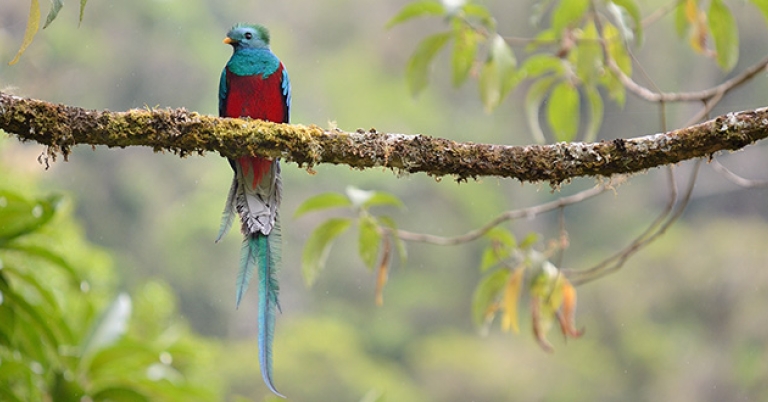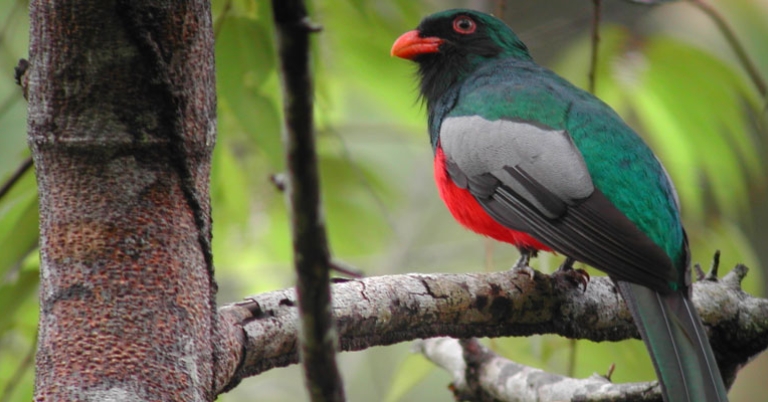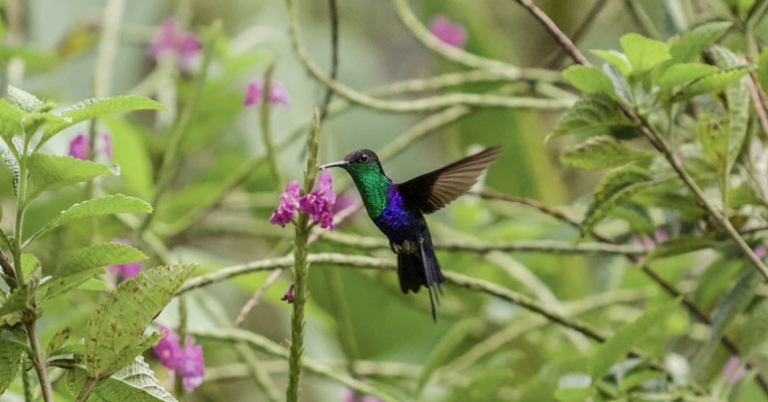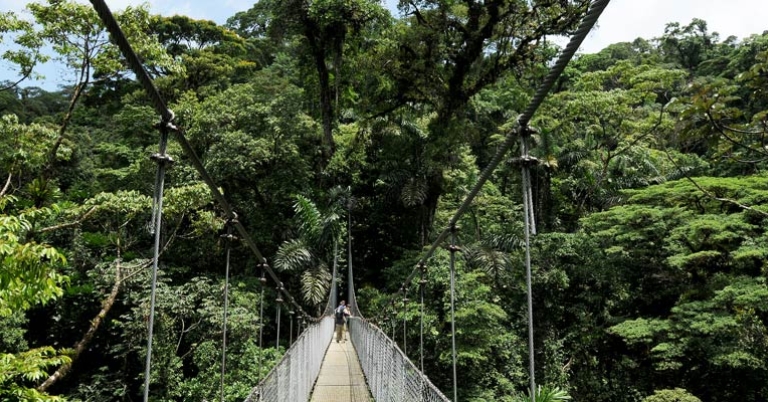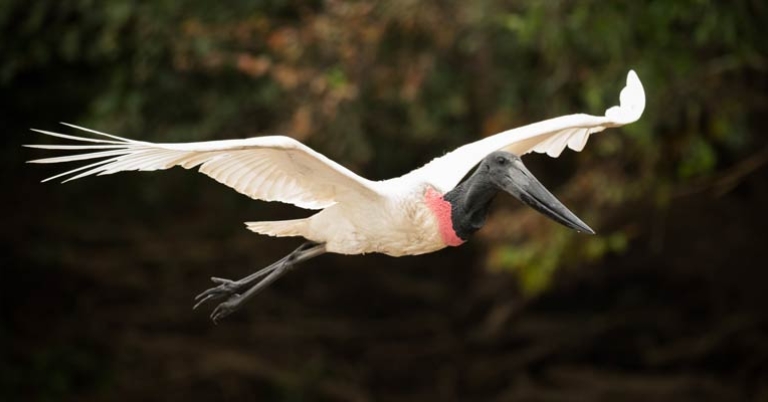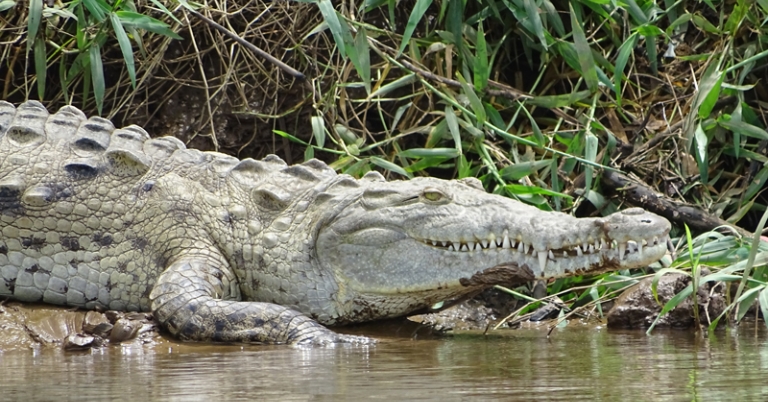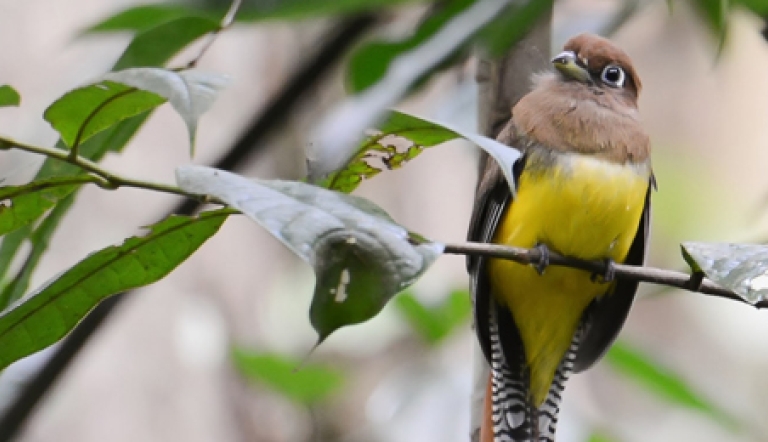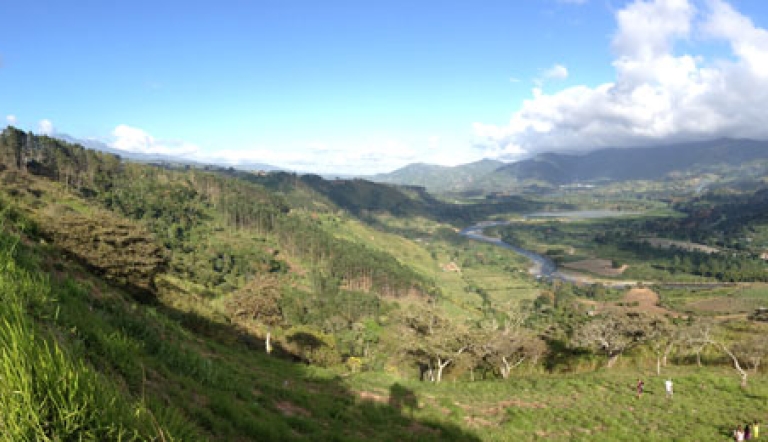Costa Rica | Birding with Paul Regnier
About this trip
Embark on a comprehensive excursion perfect for avid birders wishing to add to their life list: You’ll be rewarded with ample opportunities to seek out some of the hundreds of avian species that call Costa Rica home. Join Paul Regnier to visit hotspots encompassing a variety of habitats—such as Caribbean lowlands, premontane forest, tropical dry forest, mangroves, páramo, and more—during hikes, boat rides, and a hanging bridge canopy tour. Accompanied by one of our expert Costa Rican birding guides, you'll look for sought-after residents and migrant species and experience the breadth and depth of the country's diverse natural beauty.
Highlights
- Bird the trails of the world-renowned La Selva Biological Station, where more than half of Costa Rica’s species have been recorded.
- Boat through Caño Negro Wildlife Refuge, a Ramsar wetland that provides important habitat for thousands of migratory water birds.
- Enjoy excellent vantage points—including grassland, secondary forest, a river, and a natural spring—at a private ecological reserve near Arenal Volcano.
- Spend a full day in Carara National Park, an ecologically diverse hotspot due to its location at the convergence of northwestern tropical dry forest and humid southern Pacific rainforest.
- Seek out regional endemics like the Volcano Junco and White-throated Mountain-gem, plus the highly coveted Resplendent Quetzal, in the temperate forest and páramo habitats of Cerro de la Muerte.
Meet your leader
 Paul Regnier
Paul Regnier
Paul Regnier is lead Naturalist and owner of Door County Nature and Travel LLC and Door County Tours LLC.
As a professional Naturalist for over 30 years, Paul has led natural history and eco tours for organizations like the University of Wisconsin-Stevens Point, Iowa State University Extension 4H, National Sierra Club, University of Wisconsin-Madison Friends of the Arboretum, Natural Resources Foundation of Wisconsin, The Ridges Sanctuary, The Clearing and more. His tour destinations to spectacular natural areas span the globe: from the rich, wildlife-laden savannah wilderness of the Maasai Mara in Kenya to Lake Superior’s cool blue waters of Isle Royale National Park. He regularly leads natural and cultural history, birding and hiking tours in Door County, Wisconsin.
Paul graduated from the University of Wisconsin-Stevens Point with a B.S. in Natural Resource Management and a Masters in Environmental Education and Interpretation. Prior to starting his full-time business, he was the Executive Director of the Ridges Sanctuary in Baileys Harbor, Wisconsin for 15 years and Executive Director for the Warren County Conservation Board for 6 years. His leadership with both organizations was exemplified with dramatic increases in protected land, grant money, and program development.
$4,345
Per person
About this price
Land cost only. Does not include round-trip airfare to and from destination.
Single room supplement $525
What makes us different
Carbon offsetting
Wildlife up-close
Service anytime
Top birding guides
Bird-based tourism
Unique Itineraries
Daily Itinerary
Print ItinerarySan Jose
Sarapiqui
Sarapiquí
Sarapiquí
Caño Negro
Caño Negro
Arenal
Arenal
Carara
Carara
San Gerardo de Dota
San Gerardo de Dota
Alajuela
Farewell!
Pricing
Print Pricing$4,345
Per person
About this price
Land cost only. Does not include round-trip airfare to and from destination.
Single room supplement $525
What's Included
- Accommodations with private bathrooms
- Activities and meals as mentioned in itinerary
- Arrival and departure transfers based on individual flight schedules
- Bottled water or water refill station during transfers
- Carbon Offset
- Full time expert birding naturalist guide for duration of program
- Non alcoholic beverage with meals
- Private transportation and driver for the duration of the program
What's Not Included
- International airfare
- Items of personal nature
- Tips
- Travel Insurance
- Trip cancellation coverage
Pricing Details
A $350 per person deposit and enrollment form is due to hold your space on this trip. This deposit is refundable 95 days prior to departure excluding a $100 cancellation fee. Cancellations after this date are non refundable.
Holbrook Travel strongly recommends the purchase of travel protection for medical emergencies while traveling and to protect your investment. Please note the purchase of Cancel for Any Reason Coverage or to exclude pre-existing conditions with Trip Cancellation coverage may require policy purchase within 10-14 days of your initial deposit, depending upon the provider.
Single room supplement $525
Final payment due date: December 13, 2023
Travel Info
Print Travel InfoEntry & Exit Requirements
U.S. citizens must have a valid passport to enter Costa Rica. Passports must be valid for at least the duration of your stay. As this requirement is subject to change at any time without notice, we recommend at least 6 months' validity.
A visa is not required for visits up to 90 days.
If you are not traveling with a U.S. passport, please check with the Costa Rican Embassy for the requirements based on your nationality.
Health Information
IMMUNIZATIONS
The Centers for Disease Control recommends that all travelers be up to date on routine vaccinations such as measles-mumps-rubella (MMR) vaccine, diphtheria-pertussis-tetanus vaccine, varicella (chicken pox) vaccine, and your yearly flu shot before every trip.
There are no vaccinations required for entry into Costa Rica, unless you are traveling from a country where yellow fever transmission is a risk.
The CDC recommends vaccination against hepatitis A, hepatitis B, and typhoid for most unvaccinated travelers to Costa Rica.
Please consult your physician for additional information and recommendations based on your individual circumstances.
MALARIA
Malaria is caused by a parasite found in Anopheles mosquitos, which are active from dusk until dawn. The CDC advises that the risk of malaria in Costa Rica is low, but travelers should still take precautions against mosquito bites. Cover exposed skin with lightweight, long-sleeved shirts and pants, consider treating clothes with permethrin, and use an insect repellent containing an active ingredient like DEET or picaridin. Apply sunscreen first, followed by the repellent (preferably 20 minutes later).
DENGUE FEVER & OTHER INSECT-BORNE ILLNESSES
Locally transmitted cases of dengue fever have been reported in Costa Rica. Local transmission means that mosquitoes in the area have been infected with dengue and are spreading it to people. In addition, locally transmitted cases of chikungunya, Zika virus, and other insect-borne illnesses have previously been reported in Costa Rica.
Travelers to Costa Rica should protect themselves against insect bites using the measures described above. As a precaution, the CDC advises women who are pregnant to consider postponing travel to any area where Zika virus transmission is ongoing.
SUN EXPOSURE
The effects of the sun can be damaging to the eyes and skin. Spending time outdoors exposes you to the sun’s harmful ultraviolet (UV) rays, even on cloudy days. To protect yourself from the sun, use a broad spectrum sunscreen of at least SPF 15, protect skin with clothing, wear a wide-brimmed hat and sunglasses, and drink plenty of fluids.
ALTITUDE SICKNESS
If your itinerary includes locations at high elevation (above 5,000 feet), altitude sickness is a possibility. Stay hydrated and well-rested, and avoid heavy, fatty foods and alcohol in the days before arrival. Consult your physician prior to travel for advice specific to your situation.
Resources
Print ResourcesPacking Recommendations
Everyone has personal preferences when it comes to packing; for this reason, the information below is offered as a general guide and not a definitive list. You know yourself best: Use your discretion and pack what you think will serve you, based on your personal preferences and specific itinerary.
You may find many of the items below in our Gear Store.
CLOTHING
Casual, comfortable clothing is suitable for most activities in Costa Rica. You may wish to bring a slightly nicer outfit or two (eg sundress, polo shirt) if your itinerary includes dinners out or more formal activities.
Bring enough clothing suitable for the length of your program. If you prefer to pack light, note that many hotels offer laundry services at additional cost. If you plan to hand-wash items, remember that humidity may delay drying time.
Pack clothing that can be worn in layers to adapt to weather changes throughout the day. Costa Rica’s rainy season is May through November, but it can rain at any time. Clothing that wicks away moisture and dries quickly is recommended.
If your program includes visits to higher elevations (e.g. Savegre, Monteverde, or Cordillera de Talamanca), warm clothing is strongly recommended. Temperatures can get quite chilly, especially at night and early in the morning, and hotel rooms don’t always have heat. It can also be windy at times. Consider packing a warm underlayer, as well as a warm, protective outer layer.
For birding programs, pack muted colors such as khaki, olive, and forest green. If participating in turtle patrols, bring dark-colored pants and shirts.
- A combination of short-sleeved and lightweight, long-sleeved shirts for sun and mosquito protection
- Shorts
- Lightweight, quick-drying long pants for sun and mosquito protection; jeans tend to be uncomfortable in hot and humid conditions, but are fine in the cooler highlands.
- Undergarments
- Sleepwear
- Lightweight jacket or sweater/sweatshirt (or heavier weight if visiting high-elevation areas)
- 1-2 bathing suit(s) for the beach, if applicable, plus many hotels have pools
- Socks – Bring extra pairs. If your itinerary indicates muddy hikes with rubber boots provided on-site, pack a few pairs of knee socks to prevent blisters.
- Shoes – Consider your specific itinerary when choosing footwear. For most programs, you’ll likely want at least one pair of comfortable, closed-toe walking or hiking shoes suitable for forest hikes and walking over cobblestones or other uneven terrain. Sturdier hiking boots may be appropriate for more active itineraries. In addition, many participants opt for a pair of sturdy sport-strap sandals (e.g. Keens, Tevas, or similar) and/or casual flip-flops or sandals. If you’re whitewater rafting or visiting the beach, you may also want a pair of aqua socks, reef walkers, or water shoes.
- Lightweight rain jacket, hooded poncho, and/or windbreaker
- Visor or wide-brimmed sun hat
- Bandana, scarf, or neck gaiter
Personal Toiletries
Pack toiletries based on your personal preferences and habits. Below are just a few recommendations to keep in mind.
- Shampoo, conditioner, lotion, deodorant/antiperspirant , etc. – If possible, avoid strong fragrances if you are sensitive to insect bites (and to be considerate of you fellow travelers).
- Soap and washcloth or a small, quick-drying microfiber towel – Washcloths are not standard in all hotels. If you normally use a washcloth, you may wish to bring one from home.
- Hairbrush, comb, hair ties, shower cap. Most—but not all—hotel rooms provide a hair dryer, but you may wish to bring one from home.
- Toothbrush and toothpaste
- Razor
- Ear plugs, especially if you are a light sleeper
- Personal hygiene products
- Insect repellent with DEET or picaridin (see note below about treating clothing with permethrin)
- Sunscreen and lip balm with SPF – If you’ll be in the ocean, we recommend reef-safe sunscreen.
- Aloe vera gel
- A travel pack of tissues – also useful as napkins or toilet paper if needed
In addition to your personal toiletries, it is useful to pack a small medical kit, which you can easily prepare. Helpful items might include: bandages, antihistamine, a pain reliever, motion sickness and/or altitude sickness medication (if you are prone to either), anti-diarrhea medicine, individually wrapped pre-moistened towelettes and/or hand sanitizer, antibiotic ointment, anti-fungal cream, moleskin for blisters, eye drops, tweezers, a mini sewing kit, and an extra pair of disposable contact lenses or eyeglasses if you wear them.
Days before you leave home, you may wish to consider spraying any clothing, socks, and shoes that will be worn in lowland, tropical sites with permethrin, an anti-parasite medication, to repel irritating pests and prevent the spread of disease. A recommended brand is Sawyer. Carefully read all instructions before use. Please note permethrin is highly toxic to cats and fish, and some aerosol products may be harmful to birds. Side effects may include minor itching, burning, or redness. You may want to use a laundry marker to label and keep track of which socks are permethrinized. Only one application per item is necessary; permethrin on treated clothes remains effective through several washings. Permethrin should NOT be applied directly to skin.
Miscellaneous
Remember to pack valuables such as your passport, cash/credit cards, and medications in your carry-on luggage.
- Passport and photocopies of all travel documentation
- Personal insurance card and travel insurance information
- Money – ATM/credit card, traveler's checks, and/or cash; small bills in good condition are recommended
- Prescription medicines (if applicable), with a copy of the prescription
- Yellow fever certificate (if required; only if arriving from a country where yellow fever transmission is a risk)
- Sunglasses with strap
- Small day pack for hikes and excursions
- Flashlight and/or head lamp
- Travel alarm clock or inexpensive waterproof wristwatch with alarm – Not all hotels provide alarm clocks.
- A pocket calculator or phone to assist with conversions and currency exchange
- Binoculars with lens cleaner
- Camera and related equipment, such as charger, lenses, and extra memory cards
- Reusable water bottle – especially important in national parks, which do not permit single-use plastic bottles or containers
- Non-perishable snacks
- Pocket-knife or multipurpose tool - Pack in your checked luggage
- Zip-top style bags – useful for packing toiletries, sorting clothing, storing damp or muddy shoes, or as a dry bag for protecting electronics
- Notepad or travel journal and pen
- Music or reading material for down time, long bus drives, or on the airplane, and a portable bright light to read by
- Collapsible walking stick with rubber tip
- A small quantity of laundry detergent if you’ll be washing clothing by hand
- Travel-size umbrella – Some people find this unwieldy to carry, while others find it offers better protection than a rain jacket alone.
- Money belt
- Chargers for electronics

Questions
Contact Debbie Jordan at 866-748-6146 or debbie@holbrooktravel.com
